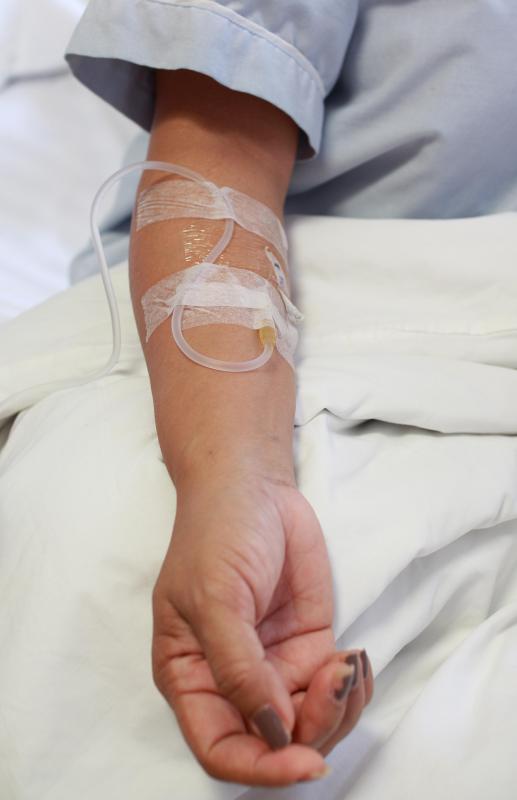At WiseGEEK, we're committed to delivering accurate, trustworthy information. Our expert-authored content is rigorously fact-checked and sourced from credible authorities. Discover how we uphold the highest standards in providing you with reliable knowledge.
What is Intravenous Fluid Therapy?
Intravenous fluid therapy is a commonly used procedure in hospitals and medical facilities that delivers fluids through sterile tubing into a needle inserted into a vein. A large percentage of patients in a hospital will undergo this therapy, often just called an IV. This procedure can be used to provide hydration, nutrition, to transfuse blood, or to administer medications.
The primary reason IV therapy is so widely used is forces fluids to enter the body quicker than any other route. An intravenous fluid therapy delivery system is convenient for medical professionals because it is easy to administer and to change fluids as needed. Since the apparatus can be hung from a pole on wheels, the patient can maintain mobility and walk while attached to the IV.

A basic intravenous fluid therapy system consists of a collapsible bag or bottle of solution, a drip chamber that controls flow rate, connectors, and a needle held in place by dressing. The needle is usually inserted into a vein, often in the hand or arm. Veins are used because they are close to the surface of the skin, easy to see, and unlike arteries, do not pulse.

Flow rate can be controlled by an infusion pump that has a timer and controls amount administered. A gravity drip may be used by hanging the bag higher than the patient. Syringe pumps administer small amounts of concentrated medications. They may be used when fluids need to be administered less frequently and when patients cannot tolerate constant infusion with fluids.

There are two types of fluids used in intravenous fluid therapy: crystalloid and colloid. Crystalloid solutions are sterile water mixed with electrolytes. The two most commonly used crystalloid solutions used in the United States are normal saline and lactated Ringers. Colloids are crystalloid fluids that have an additional substance made up of larger particles that are too large to pass through the vein wall. Although rarely used due to expense, they are sometimes needed to reduce edema and control blood volume.

As with most medical procedures, there is a risk of infection with intravenous fluid therapy. The most common complication is phlebitis, a condition in which the vein wall becomes inflamed, causing pain and swelling, usually of the leg. Sometimes a blood clot may form near the site of inflammation. Phlebitis is treated with heat, elevation, and anti-inflammatory drugs, like aspirin or ibuprofen, and removing the IV and reinserting at another site.
AS FEATURED ON:
AS FEATURED ON:















Discussion Comments
My daughter works as a nurse and administering and changing an IV is a daily part of her job. Once someone has an IV in, it is fairly easy to maintain and make sure the patient is receiving everything they need.
I was in the emergency room after I had a reaction to a bee sting and had an IV for the day I was there. I am not sure what kinds of fluids they had in there, but it sure made me go to the bathroom a lot.
Thankfully I was well enough to get up and move around so I could do this as often as I needed to. You would also think that after not eating anything for a day, I would lose a few pounds.
When I got home from the hospital and weighed myself the next day, I had gained 2 pounds. It must have been from all the fluid I received through the IV because I quickly lost it. Nobody likes to have an IV, but it is better than what some other alternatives would be.
I was in the hospital for a week after I had an emergency surgery for a ruptured appendix. Since I couldn't eat anything for several days, the IV was my main source of nutrition.
Usually if I go very long without food I get a bad headache. With the IV I still had a dull headache, but not nearly as bad as I would usually have without eating solid food.
I know that nobody looks forward to having an IV, but I especially dread it. It takes someone who has a lot of experience to get an IV inserted in me the first time.
My veins have a tendency to collapse once the needle is inserted. This means to have to pull the needle out and try again. Sometimes they have to go find someone else who is more experienced to get the job done.
This means that my arm gets poked several times before the IV is inserted correctly. Once that part is over with, the rest isn't so bad.
Post your comments